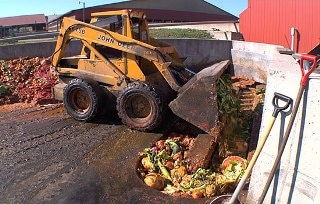Nov 13 2018
Scientists at RIT are busy when it comes to identifying creative and new ways to lessen food waste.
 RIT researchers are identifying creative and innovative ways to mitigate food waste. It’s estimated that as much as 40% of edible food in the U.S ends up in landfills. (Credit: RIT)
RIT researchers are identifying creative and innovative ways to mitigate food waste. It’s estimated that as much as 40% of edible food in the U.S ends up in landfills. (Credit: RIT)
The stakes are high. With the ever-growing world population and a dwindling pool of natural resources, the world, at present, faces an extraordinary challenge to provide a robust food supply—made even more difficult by massive inefficiencies and resulting food waste created across the food supply chain. It’s likely that as much as 40% of edible food in the U.S gets thrown into landfills.
The Golisano Institute for Sustainability (GIS) is utilizing food waste treatment technology and equipment in its latest food waste utilization testbed—the goal of which is to share results with businesses—by using leftover food from RIT’s dining halls.
Thomas Trabold, associate professor and sustainability department head at GIS, is heading a team of scientists exploring how best to enhance fermentation growth parameters in the creation of filamentous fungal mycelium—used by therapeutic New York state mushroom producer Empire Medicinals, located in Rochester, N.Y.
The one-year project is exploring the potential of GIS’s commercial project partner using extra whey—a common waste product in the yogurt business—in a stirred tank reactor as a production resource for the commercial mushroom sector. RIT scientists are also doing an economic assessment of whey and its scalability as a food waste “upcycling” and re-use alternative to wastewater treatment for the New York state dairy sector.
Companies seem to be coming to the understanding that materials that were once considered waste can now be a resource converted to secondary products.
Thomas Trabold, Associate Professor and Sustainability Department Head, GIS.
The study is made possible by an approximately $50,000 grant from FuzeHub, a not-for-profit organization that offers small- to medium-sized manufacturing companies in New York State with guided access to a network of business and technical resources.
New York State companies also are looking to the New York State Pollution Prevention Institute, headquartered at RIT, which is working meticulously with the state Department of Environmental Convention on numerous efforts to decrease the generation of food scraps and recycled food scraps that remain through programs that will aid food waste generators multiply their sustainability efforts.
For the time being, Callie Babbitt, an associate professor at GIS, is close to the midway point of an almost $1 million award from the National Science Foundation investigating sustainable solutions for reducing and handling the growing and complex challenges of food waste generated across the food supply chain.
The four-year project involves an interdisciplinary research partnership with faculty from five RIT colleges. Babbitt’s research team is examining how advanced technologies, waste management systems, and policies can decrease the volume and environmental influences of food waste—while simultaneously creating economic growth and maximizing efficient use of energy and water resources.
Trabold and Babbitt both were requested by technical publisher Elsevier to co-edit a new book this year titled, Sustainable Food Waste-to-Energy Systems. The book comprises of chapters on the newest developments in anaerobic digestion, bioelectrochemical and thermochemical conversion technologies, accompanied by policies associated with food waste management and analyses of economic and environmental aspects of waste-to-energy systems. It also includes contributions from present and former GIS Ph.D. students as well as scientists from top universities.